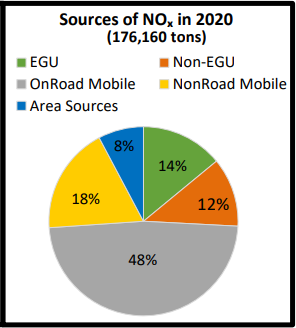2023 Ozone Season Recap
What's up, Forsyth??
Before we recap our 2023 ozone season, first we will provide some context on the air quality monitoring and forecasting activities of our office. To start, did you know that ground-level ozone (O₃) and fine particulate matter (PM2.5) are the two most concerning air pollutants for public health in Forsyth County and in the state of North Carolina?
The Environmental Protection Agency (EPA) determines National Ambient Air Quality Standards (NAAQS) for acceptable or "satisfactory" concentrations of ozone, particulate matter, and the other criteria air pollutants. These research-informed thresholds are set for the protection of public health and welfare, and they are evaluated every few years based on the latest scientific findings. In Forsyth County, we are in attainment of the NAAQS for each of the criteria air pollutants. However, it may become more challenging to maintain this status for PM2.5 and ozone since NAAQS may need to become more protective in the future, as well as the challenges that will come with warmer temperatures and projected population growth in the Triad.
To ensure that we are not exceeding NAAQS, the Forsyth County Office of Environmental Assistance and Protection (EAP Office) continuously measures concentrations of criteria air pollutants using highly accurate regulatory air quality monitors. For ozone specifically, we monitor and provide daily Triad air quality forecasts from March 1st-October 31st in accordance with EPA requirements. As a secondary pollutant, ozone is not emitted directly from pollution sources but instead forms when volatile organic compounds (VOCs) react with nitrogen oxides (NOx) in the presence of heat and sunlight. With heat and sunlight being the catalyst for the reaction, the highest concentrations of ozone occur during summer months. We monitor and forecast for PM2.5 365 days/year since particulate matter concentrations have the potential to reach unhealthy levels year-round.
Figure 1 shows NOx emissions by source in 2020 according to the North Carolina Division of Air Quality’s “Air Quality Trends in North Carolina” (September 2023). Roughly half of the state's NOx emissions come from on-road mobile sources (cars, trucks, buses). Other significant sources include 1) off-road mobile sources (like airplanes, ships, trains, construction equipment, and gas-powered lawn equipment), and 2) point sources like EGUs (electricity generating units, aka “power plants”) and industrial sources (called non-EGUs in Figure 1).
Figure 1. NOx emissions by source in 2020 from North Carolina Division of Air Quality’s “Air Quality Trends in North Carolina” (September 2023).
During ozone season, our office
monitors ozone concentrations at three sites. Ozone monitors have been strategically placed in order for us to get the best picture of what ozone concentrations Forsyth County residents are being exposed to.
Figure 2. Office of Environmental Assistance and Protection-operated ozone monitors in Forsyth County, NC. Values shown are for the maximum 8-hr concentration for ozone on August 21, 2023. This screenshot was taken from the North Carolina Climate Office and North Carolina Department of Environmental Quality’s Ambient Information Reporter.
As most people living in the eastern
US already know, the Canadian wildfire season significantly affected
air quality this summer (see Figure 3). We had 7 days where the Air Quality Index (AQI) was in the
code orange range or higher. Out of those seven, five were due to elevated
levels of PM2.5. For the two days that the AQI for ozone reached
code orange levels, they were likely still related to the wildfires since
smoke
from fires can produce precursor pollutants leading to ozone formation.
Figure 3. Hazy skies seen from downtown
Winston-Salem on June 29, 2023.
It is also worth noting that AQI values for both ozone and PM2.5 reached higher levels on more days this summer compared with the previous 4 years (see Figure 4). The wildfires elevated O₃ and PM2.5 concentrations even when they were within the satisfactory levels (AQI values of 100 or less). Figure 5 shows AQI results for ozone only from 2019-2023.
Figure 4. Forsyth County, NC AQI Results for PM2.5 and ozone from 2019-2023. For 2023, data were available only through November 26th.
While weather patterns, such as the winds funneling PM2.5 from Canada all the way to North Carolina, can significantly impact air quality, we cannot underestimate the importance of voluntary actions to reduce ozone formation. As Figure 1 shows, our cars are the biggest culprit, so finding ways to drive less and improve fuel economy (including driving the cleanest vehicle that meets our needs, keeping our cars well-maintained, and avoiding aggressive driving habits like speeding and tailgating) is key. In 2020, we had the highest number of code green days, which may be because many Americans stayed at home during the Covid-19 pandemic. To learn more about how to reduce vehicle-related pollution, check out NC Air Awareness's page on vehicle emissions reduction activities.
It is especially important that we make every effort to reduce ozone-forming emissions when there’s the potential to cross the AQI threshold from yellow to orange, or orange to red. Some examples include driving less and staying home if possible, avoiding engine idling, and waiting until a non-ozone action day to use gas-powered lawn equipment. It also helps to conserve electricity by raising the thermostat on warmer days and lowering it on cooler days, as well as turning off lights and unplugging devices when not in use.
While ozone season won't start up again until March 1st, it's never too early to implement these pollution reduction strategies, as there are year-round associated environmental, health, and monetary benefits!








Comments
Post a Comment